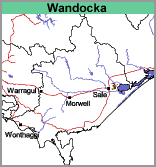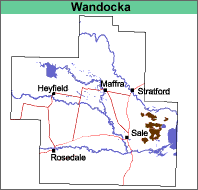Wandocka (Wa)
|
Geology |  |  |
Original Vegetation
It is likely that this map unit was predominantly grassland (Lunt, 1997) with only about 6% of the area timbered.
Previous Maps and Reports
All of the areas mapped as Wandocka clay loam in the Nambrok area by Skene and Walbran (1948) are included here in the Denison map unit. To the east and north-east of Sale there are extensive areas of this soil type and for this reason it is mapped into the Wandocka map unit.
Ward (1977) mapped this map unit into his Bundalaguah soil association.
Soils
The surface soils are generally dark brownish grey clay loams grading into similarly coloured light clay at about 15 cm. These overlie mottled dark brownish grey and yellowish brown medium clay at about 30 cm which then grades into a mottled medium to heavy clay with grey, yellow and brown colours predominating. The soils are generally classified as Brown and Black Dermosols and Vertosols using the Australian Soil Classification.
Chemical and Physical Analysis
Analysis is provided for Soil Pit Site GP71 below. Analysis is also available for one site from (Skene and Walbran, 1948, 1949) and is described below The pH’s of the surface soils are generally between 5.5 and 6.0. and with depth the soils become strongly alkaline. They are all believed to be sodic in the subsoil.
GP71. Soil Pit Site (Sargeant and Imhof, 2000)
Depth cm | Texture | pH | EC dS/m | Nitrogen % | Carbon % | Ca meq% | Mg meq% | K meq% | Na meq% | H meq% | ESP % | Coarse sand % | Fine sand % | Silt % | Clay % | LAT % |
0-15 | CL | 5.8 | 0.22 | 0.33 | 3.9 | 7.0 | 4.5 | 0.7 | 1.3 | 13.0 | 5 | 5 | 35 | 22 | 28 | 2 |
15-30 | LMC | 6.4 | 0.10 | 0.13 | 1.8 | 5.9 | 5.8 | 0.3 | 1.2 | 9 | 3 | 30 | 21 | 42 | 1 | |
30-60 | MC | 8.2 | 0.22 | 5.1 | 8.8 | 0.3 | 2.8 | 17 | 3 | 38 | 22 | 33 | 1 | |||
60-90 | MC | 8.6 | 0.47 | 3.8 | 8.8 | 0.2 | 4.0 | 28 | 3 | 39 | 21 | 36 | 1 | |||
90+ | LMC | 8.9 | 1.00 | 3.5 | 6.6 | <0.1 | 8.1 | 47 |
Wandocka clay loam, (Skene and Walbran, 1949)
Depth cm | Texture | pH | EC dS/m | Cl % | Nitrogen % | Carbon % | Ca meq% | Mg meq% | K meq% | Na meq% | ESP % | Coarse sand % | Fine sand % | Silt % | Clay % | LAT % |
0-15 | CL | 5.9 | 0.12 | .025 | 0.241 | 2.98 | 3.6 | 3.6 | 0.1 | 0.2 | 3 | 15 | 37 | 36 | 2 | |
15-25 | LC | 5.7 | 0.10 | .033 | 5 | 15 | 36 | 40 | 1 | |||||||
25-38 | HC | 6.4 | 0.14 | .027 | 4.8 | 7.0 | 0.1 | 1.5 | 11 | 2 | 8 | 27 | 57 | 2 | ||
38-56 | HC | 7.0 | 0.24 | .050 | 1 | 5 | 25 | 64 | 1 | |||||||
56-71 | HC | 8.0 | 0.32 | .072 | 1 | 6 | 30 | 59 | 1 | |||||||
76-122 | HC | 8.7 | 0.55 | .129 | 3.7 | 10 | 0.2 | 4.5 | 24 | <1 | 4 | 29 | 64 | 2 |
The following abbreviations are used to describe field texture: S - sand; LS - loamy sand; ClS - clayey sand; SL - sandy loam; L - loam; CL - clay loam; SCL - sandy clay loam; SC - sandy clay; FSCL - fine sandy clay loam; FSC - fine sandy clay; LC - light clay; MC - medium clay; HC - heavy clay; GR - gravel; ZL - silty loam; ZCL - silty clay loam; ZLC - silty light clay; ZMC - silty medium clay.
Particle size distribution data given for Skene and Walbran (1948, 1949) does not include the water content of the soil. As a result the coarse sand, fine sand, silt, clay and loss on acid treatment (LAT) may not add up to 100%.
Other symbols include: pH - analysed in water; EC - electrical conductivity; Cl - chloride; Ca - exchangeable calcium; Mg - exchangeable magnesium, K - exchangeable potassium; Na - exchangeable sodium; H - exchangeable hydrogen; ESP - exchangeable sodium percentage.
For Soil Pit Sites (Sargeant and Imhof, 2000) exchangeable cations have been determined using Gilman method (where pH >7) and Tucker method (pH <7). Exchangeable Sodium % (ESP) has been calculated here as the percentage of sodium in relation to the sum of the exchangeable basic cations.
Land Use
These soils are heavier in texture than those of the Denison mapping unit and it was recognised in 1949 that they were inclined to be saline.
Wandocka, clay surface (Wa,c)
This map unit occurs in a similar landscape position as the Wandocka map unit but rather than having a clay loam surface soil, these soils have a light clay or light medium clay surface soil. Skene and Walbran (1948) described such soils as “crabholey …. where such areas have only a few inches of A horizon, they are defined and inscribed as “shallow” or “shallow and heavy surface”. It is likely that such soils would be classified as Grey Vertosols using the Australian Soil Classification.
Analysis is provided for one site from (Aldrick et al., 1992).
Profile 28, Nambrok 2, (Aldrick et al., 1992)
Depth cm | Texture | pH | EC dS/m | Cl % | Nitrogen % | Carbon % | Ca meq% | Mg meq% | K meq% | Na meq% | H meq% | ESP % | Gravel % | Coarse sand % | Fine sand % | Silt % | Clay % |
0-3 | CL | 5.8 | 0.83 | .100 | 0.57 | 6.63 | 3.9 | 8.2 | 1.6 | 3.9 | 15.8 | 12 | 1 | 1 | 12 | 34 | 41 |
10-20 | MC | 8.1 | 0.53 | .059 | 0.13 | 1.23 | 2.9 | 8.4 | 0.8 | 5.2 | 3.5 | 25 | <1 | 10 | 36 | 49 | |
30-60 | HC | 9.3 | 1.40 | .150 | 2.7 | 9.8 | 1.0 | 11.6 | 0.5 | 45 | 1 | 7 | 27 | 63 | |||
60-90 | HC | 9.2 | 1.40 | .150 | 2.7 | 9.6 | 0.5 | 9.3 | 42 | 1 | 1 | 5 | 23 | 70 | |||
120-150 | HC | 8.5 | 0.48 | .051 | 2.1 | 10.6 | 0.3 | 6.5 | 33 | 1 | <1 | 4 | 29 | 66 |
The following abbreviations are used to describe field texture: S - sand; LS - loamy sand; ClS - clayey sand; SL - sandy loam; L - loam; CL - clay loam; SCL - sandy clay loam; SC - sandy clay; FSCL - fine sandy clay loam; FSC - fine sandy clay; LC - light clay; MC - medium clay; HC - heavy clay; GR - gravel; ZL - silty loam; ZCL - silty clay loam; ZLC - silty light clay; ZMC - silty medium clay.
Aldrick et al., 1992 does not provide LAT data.
Other symbols include: pH - analysed in water; EC - electrical conductivity; Cl - chloride; Ca - exchangeable calcium; Mg - exchangeable magnesium, K - exchangeable potassium; Na - exchangeable sodium; H - exchangeable hydrogen; ESP - exchangeable sodium percentage.


